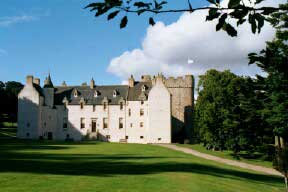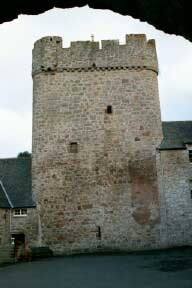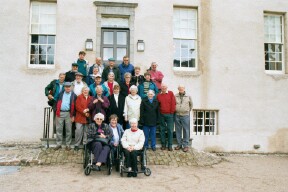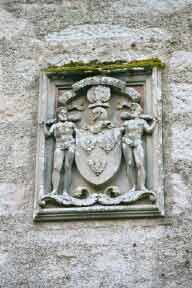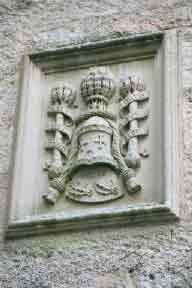Drum Castle
September 16, 2001
This day was spent visiting "Irvine Country" with David and Caro as our guides. We went to the Bridge of Feugh hoping to see salmon leaping up the rocks and then along the south side of the Dee River to the Park Bridge over the Dee where David told us about the Mid-1300 to Early 1400 feud between the Keiths and the Irvines that culminated in several Keiths being drowned in the Dee at Keiths' Pot and their leader being killed by Irvine arrows on Keiths' Stone.
Then we went north to Auchronie to a hill to see the Drum Stone, another part of the Irvine-Keith History. We visited the Irvine Caput, a portion of Drum land that enables the Barony of Drum to continue in the Irvine family as it has since 1323. Lunch was enjoyed at the nearby Irvine Arms resturant.
The afternoon was spent with David and Caro guiding us to Drum Chapel, through Drum Castle up to the battlements of the tower and to see the walled garden. The lands of Drum were received by William de Irwin as a grant from Robert the Bruce in 1323. The Castle takes its name from the Gaelic Drum or Druim which means a ridge or knoll. The oldest part of the castle is the Keep, a 70 foot massive tower with immensely thick walls. The Keep is at least 300 years older than the rest of the castle, which includes an elegant 17th Century Jacobean mansion and additional late 18th Century alterations.
The Castle remained in the Irvine family until the 24th Laird Henry Quentin Irvine entered into an agreement with the National Trust for Scotland bequeathing Drum and its 411 acres to the Trust. Quentin was succeeded in 1975 as laird of Drum and Chief of the Name by his brother Lieutenant-Colonel Charles Francis Irvine. In 1992, Charles' son David Charles Irvine succeeded as 26th laird.
We returned to the Tor-Na-Coille Hotel for the formal Irvine of Drum dinner for American and Scottish Irvines and that featured cullin skink, haggis, and salmon.
